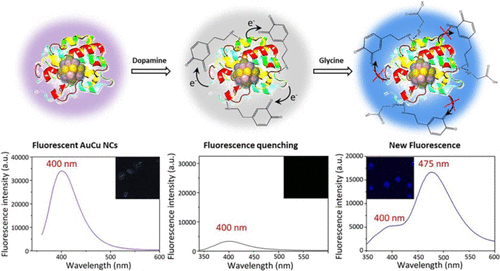Our official English website, www.x-mol.net, welcomes your
feedback! (Note: you will need to create a separate account there.)
Dopamine-Modified AuCu Bimetallic Nanoclusters as Charge Transfer-Based Biosensors for Highly Sensitive Glycine Detection
Langmuir ( IF 3.7 ) Pub Date : 2020-11-11 , DOI: 10.1021/acs.langmuir.0c02396 Zhichuan Chen 1 , Weihua Ding 1 , Yayun Gu 1 , Sheng Gao 1 , Damin Yun 1 , Chengniu Wang 1 , Wenqing Li 1 , Fei Sun 1
Langmuir ( IF 3.7 ) Pub Date : 2020-11-11 , DOI: 10.1021/acs.langmuir.0c02396 Zhichuan Chen 1 , Weihua Ding 1 , Yayun Gu 1 , Sheng Gao 1 , Damin Yun 1 , Chengniu Wang 1 , Wenqing Li 1 , Fei Sun 1
Affiliation

|
Glycine is the simplest amino acid in living organisms and plays important roles in biology and medicine. However, few biosensors for glycine sensing have been reported. Herein, we present a facile strategy to construct dopamine-modified AuCu bimetallic nanoclusters (denoted as AuCu NC–DA) as charge transfer-based biosensors for highly sensitive glycine sensing. The AuCu NCs stabilized by bovine serum albumin (BSA) exhibited a fluorescence maximum at 400 nm. Because of the high affinity of BSA for dopamine (DA), the surface of the AuCu NCs was modified with DA without any complicated chemical reactions, resulting in fluorescence quenching through a charge transfer process. Among 20 amino acids, AuCu NC–DA exhibited an off/on fluorescence switching response specifically toward glycine through the formation of hydrogen bonds with oxidized DA, which inhibited the charge transfer process, leading to the emergence of a new emission peak at 475 nm. Spectroscopic and thermodynamic results combined with molecular docking analyses provided comprehensive understanding of the sensing mechanism. Furthermore, we showed that AuCu NC–DA was able to sense glycine in cells by imaging. Finally, the practicability of AuCu NC–DA for glycine detection was validated in milk drink samples. This study presents a promising type of a charge transfer-based sensor.
中文翻译:

多巴胺修饰的AuCu双金属纳米簇作为基于电荷转移的生物传感器,用于高灵敏度的甘氨酸检测。
甘氨酸是生物中最简单的氨基酸,在生物学和医学中起着重要作用。然而,很少有用于甘氨酸传感的生物传感器的报道。在这里,我们提出一种简便的策略来构建多巴胺修饰的AuCu双金属纳米簇(表示为AuCu NC-DA),作为基于电荷转移的生物传感器,用于高灵敏度的甘氨酸传感。牛血清白蛋白(BSA)稳定的AuCu NCs在400 nm处显示最大荧光。由于BSA对多巴胺(DA)的高度亲和力,AuCu NCs的表面被DA修饰,而没有任何复杂的化学反应,从而通过电荷转移过程导致了荧光猝灭。在20个氨基酸中,AuCu NC-DA通过与氧化的DA形成氢键,表现出对甘氨酸的关闭/开启荧光转换响应,抑制了电荷转移过程,导致在475 nm处出现一个新的发射峰。光谱和热力学结果与分子对接分析相结合,提供了对传感机理的全面理解。此外,我们表明AuCu NC-DA能够通过成像感测细胞中的甘氨酸。最后,在牛奶饮料样品中验证了AuCu NC-DA用于甘氨酸检测的实用性。这项研究提出了一种有前途的基于电荷转移的传感器。AuCu NC-DA用于甘氨酸检测的实用性已在牛奶饮料样品中得到验证。这项研究提出了一种有前途的基于电荷转移的传感器。AuCu NC-DA用于甘氨酸检测的实用性已在牛奶饮料样品中得到验证。这项研究提出了一种有前途的基于电荷转移的传感器。
更新日期:2020-11-25
中文翻译:

多巴胺修饰的AuCu双金属纳米簇作为基于电荷转移的生物传感器,用于高灵敏度的甘氨酸检测。
甘氨酸是生物中最简单的氨基酸,在生物学和医学中起着重要作用。然而,很少有用于甘氨酸传感的生物传感器的报道。在这里,我们提出一种简便的策略来构建多巴胺修饰的AuCu双金属纳米簇(表示为AuCu NC-DA),作为基于电荷转移的生物传感器,用于高灵敏度的甘氨酸传感。牛血清白蛋白(BSA)稳定的AuCu NCs在400 nm处显示最大荧光。由于BSA对多巴胺(DA)的高度亲和力,AuCu NCs的表面被DA修饰,而没有任何复杂的化学反应,从而通过电荷转移过程导致了荧光猝灭。在20个氨基酸中,AuCu NC-DA通过与氧化的DA形成氢键,表现出对甘氨酸的关闭/开启荧光转换响应,抑制了电荷转移过程,导致在475 nm处出现一个新的发射峰。光谱和热力学结果与分子对接分析相结合,提供了对传感机理的全面理解。此外,我们表明AuCu NC-DA能够通过成像感测细胞中的甘氨酸。最后,在牛奶饮料样品中验证了AuCu NC-DA用于甘氨酸检测的实用性。这项研究提出了一种有前途的基于电荷转移的传感器。AuCu NC-DA用于甘氨酸检测的实用性已在牛奶饮料样品中得到验证。这项研究提出了一种有前途的基于电荷转移的传感器。AuCu NC-DA用于甘氨酸检测的实用性已在牛奶饮料样品中得到验证。这项研究提出了一种有前途的基于电荷转移的传感器。











































 京公网安备 11010802027423号
京公网安备 11010802027423号